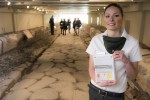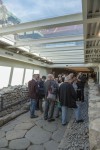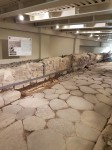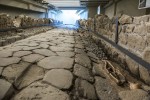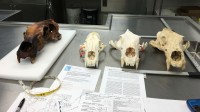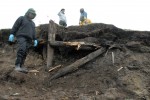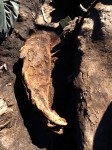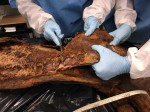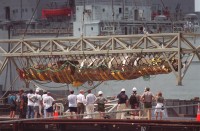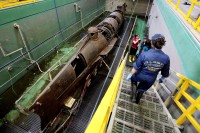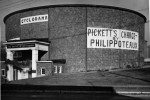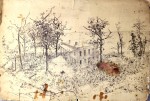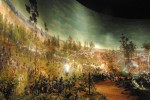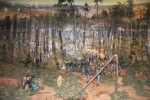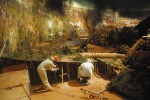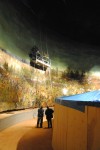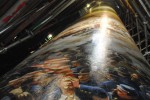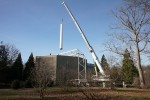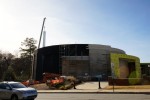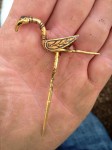 A new campaign has been launched to keep the Galloway Viking Hoard for exhibition in the county where it was found. Buried in the 10th century, the hoard was discovered by a metal detectorist in field near Castle Douglas in Dumfries and Galloway, Scotland, in September of 2014. Archaeologists excavated the hoard and found more than 100 silver and gold pieces, from ingots to jewelry to fragments of Byzantine silk to an extremely rare Carolingian pot stuffed with more treasure. The Galloway Viking Hoard is the largest Viking treasure found in Scotland since 1891.
A new campaign has been launched to keep the Galloway Viking Hoard for exhibition in the county where it was found. Buried in the 10th century, the hoard was discovered by a metal detectorist in field near Castle Douglas in Dumfries and Galloway, Scotland, in September of 2014. Archaeologists excavated the hoard and found more than 100 silver and gold pieces, from ingots to jewelry to fragments of Byzantine silk to an extremely rare Carolingian pot stuffed with more treasure. The Galloway Viking Hoard is the largest Viking treasure found in Scotland since 1891.
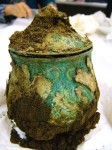 Since then, the Carolingian pot CT has been scanned and painstakingly excavated in the laboratory and the other objects cleaned and stabilized, but there’s still much more to be learned from this unique assemblage of artifacts. Bordered by the Cumbria, with its high Norse population, to the south, and the Viking-dominated Irish Sea to the west, Galloway had a strong Viking presence from the 9th until the 11th century. The person who buried the hoard was almost certain Norse, burying his or her most precious valuables, many of them heirlooms, handed down spoils from long-ago raids on Anglo-Saxon, Irish French and/or German communities. No other Viking hoard has been found with such a wide variety of objects — gold, silver, glass, enamel, textiles — from such a wide geographic area. The rare survival of textiles, the precision wrapping of each object and careful burial in order of priority makes this hoard a particularly rich source of information about Viking Galloway beyond just the value and significance of the precious objects.
Since then, the Carolingian pot CT has been scanned and painstakingly excavated in the laboratory and the other objects cleaned and stabilized, but there’s still much more to be learned from this unique assemblage of artifacts. Bordered by the Cumbria, with its high Norse population, to the south, and the Viking-dominated Irish Sea to the west, Galloway had a strong Viking presence from the 9th until the 11th century. The person who buried the hoard was almost certain Norse, burying his or her most precious valuables, many of them heirlooms, handed down spoils from long-ago raids on Anglo-Saxon, Irish French and/or German communities. No other Viking hoard has been found with such a wide variety of objects — gold, silver, glass, enamel, textiles — from such a wide geographic area. The rare survival of textiles, the precision wrapping of each object and careful burial in order of priority makes this hoard a particularly rich source of information about Viking Galloway beyond just the value and significance of the precious objects.
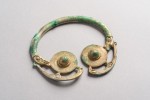 The news of the hoard made headlines all over the world and electrified its home county of Dumfries and Galloway. A pre-existing plan to convert the Kirkcudbright Town Hall into a major art gallery gained whole new steam with the prospect of the Galloway Viking Hoard as the centerpiece of the collection. The budget for the conversion was cranked way up and hefty contributions secured from the Heritage Lottery fund, the Kirkcudbright Common Good Fund and the council itself. The new Kirkcudbright Art Gallery would be a secure, state-of-the-art setting for the display of the hoard near where it was discovered.
The news of the hoard made headlines all over the world and electrified its home county of Dumfries and Galloway. A pre-existing plan to convert the Kirkcudbright Town Hall into a major art gallery gained whole new steam with the prospect of the Galloway Viking Hoard as the centerpiece of the collection. The budget for the conversion was cranked way up and hefty contributions secured from the Heritage Lottery fund, the Kirkcudbright Common Good Fund and the council itself. The new Kirkcudbright Art Gallery would be a secure, state-of-the-art setting for the display of the hoard near where it was discovered.
But the course of true hoard love never did run smooth, and some David-and-Goliath museum drama has churned in the background of this campaign. The Kirkcudbright Art Gallery doesn’t actually exist yet, while National Museums Scotland (NMS) sure does. NMS wants the Galloway Hoard. The Dumfries and Galloway Council released a statement last month expressing their support for a joint bid with NMS that would give the county and the national museum joint custody of the hoard.
In order to find a way forward, our Council has conducted a detailed options appraisal. This appraisal highlighted 3 main options that our Council could take. We could apply for sole ownership of the Hoard, we could enter into a joint agreement with NMS, or we could withdraw our interest in homing the Hoard. This appraisal provided many positive and negative reasons why each option should be explored, but mainly highlighted that the Hoard needs to have some connection with Kirkcudbright and the region, and that applying for sole ownership would bring serious financial pressures with it. It was therefore decided by Members at the meeting on 24 January to pursue a joint agreement with NMS, but for adjustments to be made to the current proposal, to give Kirkcudbright Gallery and Dumfries and Galloway as a whole, a more flexible position in terms of a joint ownership of the Galloway Viking Hoard.
 NMS totally ghosted them. Requests from the council that National Museums Scotland spell out the details of the partnership and clarify how much time the hoard would spend in Kirkcudbright went unanswered. With deadlines on the horizon and the ominous prospect of a deep-pocketed national museum bidding against the scrappy county underdog, the Galloway Viking Hoard Campaign has taken matters in hand.
NMS totally ghosted them. Requests from the council that National Museums Scotland spell out the details of the partnership and clarify how much time the hoard would spend in Kirkcudbright went unanswered. With deadlines on the horizon and the ominous prospect of a deep-pocketed national museum bidding against the scrappy county underdog, the Galloway Viking Hoard Campaign has taken matters in hand.
[Campaign chair Cathy Agnew] said: “This is a time for Scotland to take the lead. The Galloway Viking Hoard is quite extraordinary and should have pride of place in a specially created exhibition space in the new Kirkcudbright Art Gallery. Remarkable finds have so often been whisked away from the communities where they were discovered only to become a small feature in a large national museum. This is a very old-fashioned approach and in 2017 we should be making sure that regions fully benefit from their cultural riches.
“Having a collection of this kind in Dumfries and Galloway would act as a powerful magnet to bring in visitors from all over the country and overseas, benefiting the local economy by encouraging them to spend time here visiting historic sites.”
 The Scottish Archaeological Finds Allocation Panel (SAFAP), the body of the Treasure Trove Unit tasked with advising the Queen’s and Lord Treasurer’s Remembrancer which museum a treasure should be allocated to and how much the ex gratia payment to the finder and landowner should be, is scheduled to meet on March 23rd to determine their recommendation for the Galloway Viking Hoard. The campaign is hoping to make some substantial noise before that meeting in the hopes of boosting Dumfries and Galloway’s bid. The website is still a work a progress — there isn’t even a donation button yet — but for now the campaign is asking for people to send letters to the Dumfries and Galloway Council and SAFAP. They also have an email sign-up if you’d like to receive updates on the campaign.
The Scottish Archaeological Finds Allocation Panel (SAFAP), the body of the Treasure Trove Unit tasked with advising the Queen’s and Lord Treasurer’s Remembrancer which museum a treasure should be allocated to and how much the ex gratia payment to the finder and landowner should be, is scheduled to meet on March 23rd to determine their recommendation for the Galloway Viking Hoard. The campaign is hoping to make some substantial noise before that meeting in the hopes of boosting Dumfries and Galloway’s bid. The website is still a work a progress — there isn’t even a donation button yet — but for now the campaign is asking for people to send letters to the Dumfries and Galloway Council and SAFAP. They also have an email sign-up if you’d like to receive updates on the campaign.


